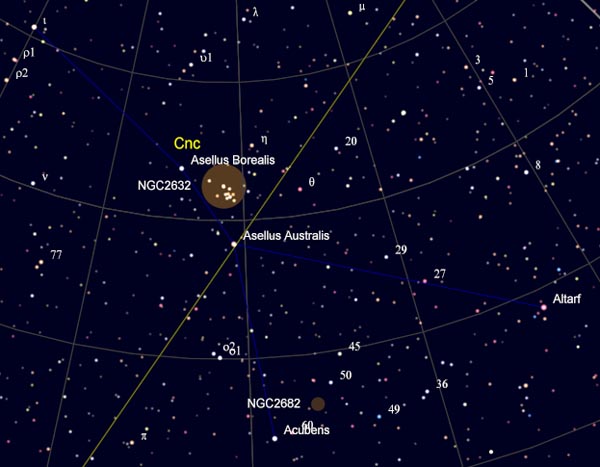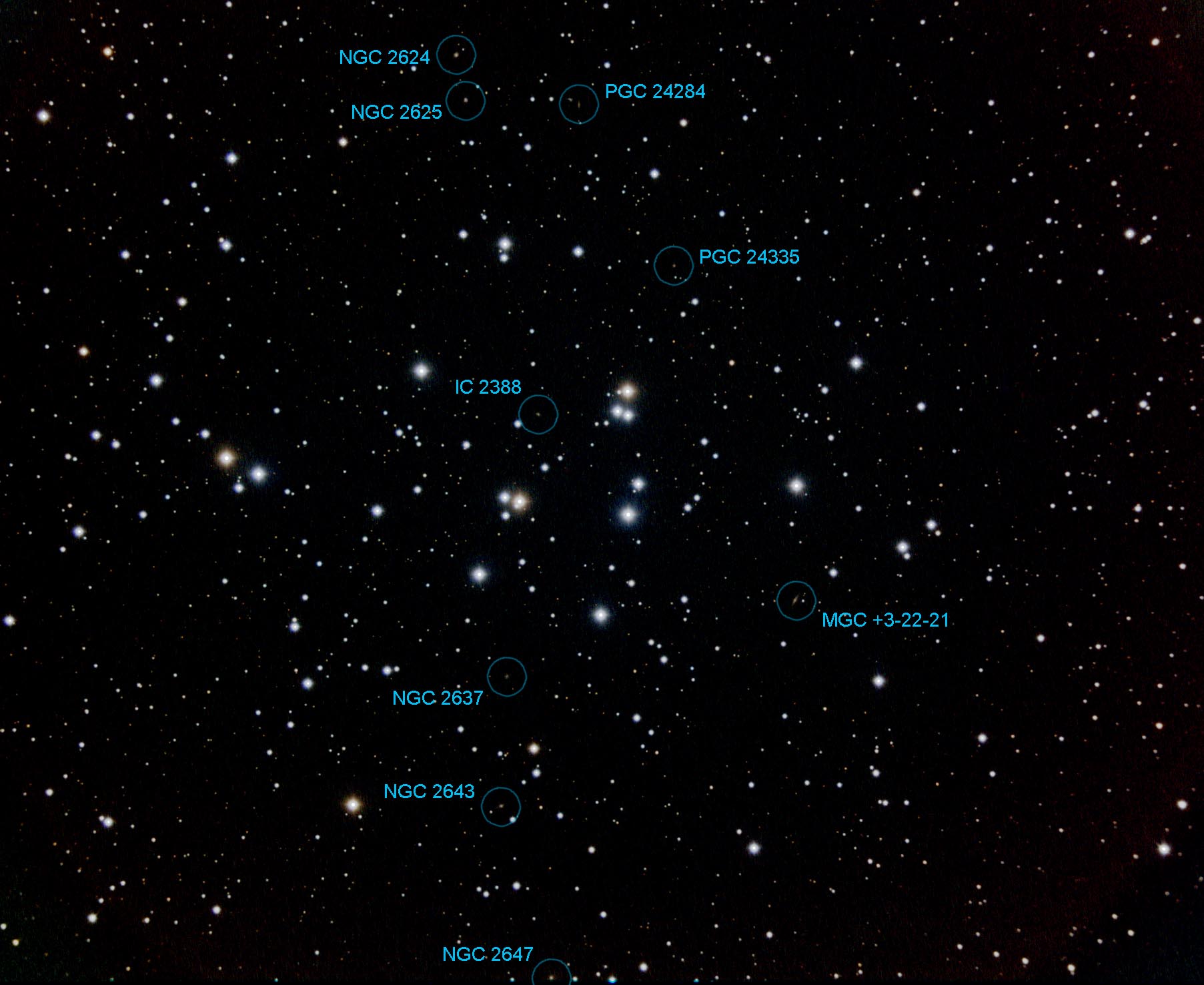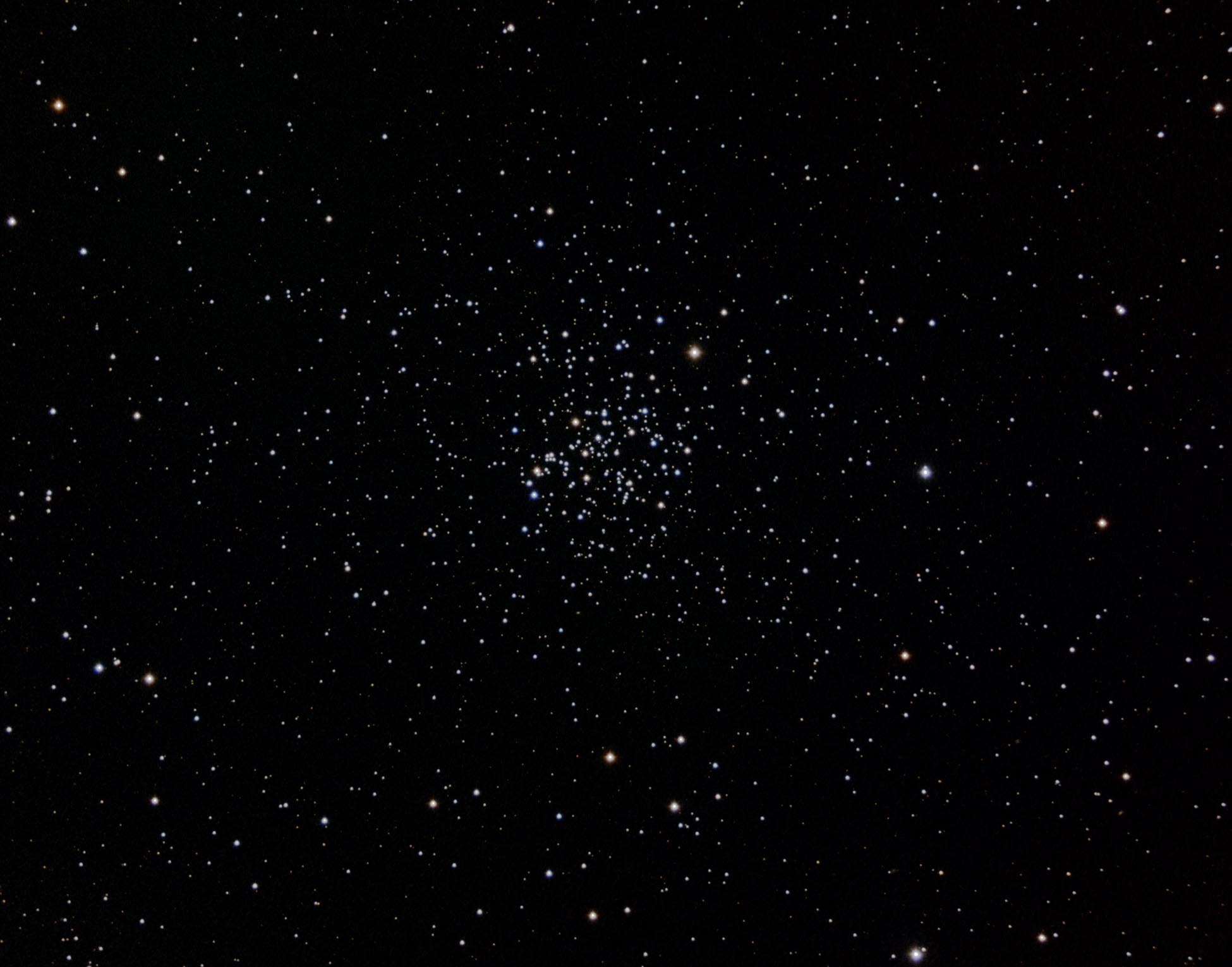
 | SOCO Blog |
9 March 2016
PRAESEPE
Winter is beginning to give way to Spring, and that means a whole new set of constellations rising up from the eastern horizon. One that is fairly prominent is the early-Spring constellation Cancer, the crab. While not an overly bright constellation (certainly not under our current light-polluted skies), Cancer contains one of the most notable and attractive deep-sky objects, particularly for viewers with binoculars or low-power telescopes. This is M 44, the open cluster that goes by the common names of the Beehive or Praesepe. With an apparent diameter of 1.2 degrees and a visual magnitude of 3.1, M 44 is easily visible to the naked eye. Galileo was the first to observe it with a telescope in 1609, where he noted in his work Nuncius Sidereus, "The so-called nebula Praesepe is not a single star but consists of a mass of more than 40 stars." The cluster actually contains arouns 200 member stars, 24 of which are brighter than magnitude 8.
As shown in Figure 1, Praesepe lies in the center of Cancer flanked by the two stars Asellus Borealis and Asellus Australis, the the Northern and Southern Asses (or Donkeys, as people now like to call them). These two stars represent the donkeys belonging to the Greek gods Dionysus and Silenus, who road them into battle against the giants known as the Titans. You wouldn't normally think that that would give you much of an advantage in battle but, apparently, the donkeys frightened the giants so much that the two gods were able to win. The name Praesepe means "crib", i.e., the thing that holds food for farm animals. So, the cluster represents the crib from which the two donkeys are feeding. It was only in the later Christian era that Praesepe became the "manger" of Jesus' birth, with the two stars becoming the donkey and ox that we traditionally find in nativity scenes. The name "Beehive" appears to refer to the "swarm" of stars making up the cluster. This seems to be a rather recent designation, although R. H. Allen in his book "Star Names" (Dover Publication, New York, 1963) states "its history as such I have not been able to learn."

Figure 1. The constellation Cancer with the the open clusters M 44 (NGC 2632) and M 67 (NGC 2682).
Source: Cartes du Ciel.
The Praesepe cluster has been known since antiquity. It was described by Aratus in 260 BC as a "small nebula". In 130 BC, Hipparchus spoke of it as the "small cloud". However, reference to it goes back much farther. As John H. Rogers describes in his article "Origins of the ancient constellations: I. The Mesopotamian traditions" (1998, Journal of the British Astronomical Association, Vol. 109, No. 1, p. 9-28), while the cluster did not appear in the MUL.APIN (the Babylonian star guide dated to the Second Millenium BCE), it was later known as "Kushu".
Charles Messier included it as number 44 in his catalog of "nebulous objects" published in 1769, along with M 42 and M 43 (parts of the Orion Nebula) and M 45 (the Pleiades). There has been some question why he added these three objects to his list, since they were already well-known among astronmers and certainly would not be confused with comets. It is likely that he included them to bring his list up to 45 objects. It should be noted that Messier's rival Lacaille published a list of 42 objects in 1755. Perhaps Messier just wanted to out-do his rival. Because it was so well-known, M 44 seems to have gotten little attention from other astronmers of that time.
Due to its large size (1.2 degrees across), I was not able to capture it in a single image, even when using the Optec NextGEN Ultra Widefield 0.7X Telecompressor with the SOCO camera. To produce an image that showed the cluster set within the surrounding space, I mosaiced five images of the cluster and its surroundings. One image was used to get the center of the cluster, while the other four made up the corners around it. Each of the five mosaiced images was itself created from 16 1-minute exposures in each of the red, green and blue spectral bands. After processing the images, the mosaic was created in Photoshop. The result is presented in Figure 2.

Figure 2. Mosaic image of the Beehive, M 44.
Since M 44 lies well outside of the stream of the Winter Milky Way, it stands out well from its background. The central part of the cluster has a physical diameter of around 6 LY. If you include the outlying stars spread across the full 1.2 degrees of the cluster, the physical size increases to around 15 LY. M 44 is relatively close, lying at a distance of 610 LY. Its age has been estimated to be around 500 to 700 million years, which is about the same age as the Hyades cluster in the constellation Taurus. When the motions of these two clusters are traced back in time, they meet at a common point of origin. Due to its age, M 44 contains a number of red giant stars. It also contains an unusually large number of variable stars.
Another interesting feature of M 44 is that its boundaries contain a large number of background galaxies. This is possible because the cluster lies outside the stream of the Milky Way away from the interstellar dust that normally attenuates the light of distant galaxies. In an article ("Galaxies in the Beehive") in the March 2016 issue of Sky and Telescope (p. 57-59), Ted Forte presents a list of nine of the brighter galaxies that can be seen in larger telescopes. Some characteristics of these galaxies are presented in Table 1 below.
Table 1. Distances and magnitudes for selected galaxies visible within M 44.
|
Figure 3 shows an enlargement of the central portion of my image of M 44. All nine of the galaxies listed in Table 1 appear in this image. Most appear as not much more than tiny smudges, but their characteristic "creamy brown" color (see my earlier blog) is a giveaway that they are not just stars. Most notable is MGC +3-22-21 which clearly shows itself as a tiny spiral galaxy with a bright central region.

Figure 3. Distant galaxies visible within the central portion of M 44.
Were it not overshadowed by M 44, the "other" open cluster in Cancer would probably be better recognized as a fine deep-sky target for observations. M 67 (NGC 2682) is a rich, relatively compact open cluster with 776 know member stars at a distance of 2960 LY. It was first described by the German astronomer Johann Gottfried Kohler around 1779. He described it as a "rather prominent nebula of longish shape." This description suggests that Kohler did not resolve the object into individual stars. His observation was not published, so Charles Messier made an independent discovery of it in April of 1780. Messier described it as a "cluster of small stars with nebulosity." Of course, there is no nebulosity associated with this cluster, so it is likely that Messier's observation was affected by the imperfect nature of the optics common to the telescopes used by early astronomers.
My image of M 67 is presented in Figure 4. It was acquired back on the night of February 6th. My acquisition of this cluster did not require the mosaicing effort used for M 44.

Figure 4. The "other" open cluster in Cancer, M 67 (NGC 2682).
M 67 has been extensively studied by astronomers because of its great age. It is one of the oldest open clusters known, with an estimated age of around 3.7 billion years. This is about the age of our Solar System. Interestingly, our Sun has a similar chemical composition as many of the stars in M 67. Studies tracing the trajectories of our Sun and M 67 around the Milky Way Galaxy suggest that our Sun was close to this cluster at one point in the distant past. Thus, it is possible that our Sun was once a part of this cluster and was at some point ejected by gravitational interactions with its sister stars. So, when you observe M 67, maybe you're looking at our "home".
I never get tired of observing and imaging open clusters. Astronomers with big scopes probably feel that way about galaxies. But with a modest-size scope like the SOCO refractor, chasing down open clusters provides a limiltless menu of sparkling objects of every size and shape. I often like to imagine what it would be like to live on a planet circling a star in a rich young open cluster— with a night sky filled with blazing blue-white suns! On such a planet, I think everyone would be an astronomer.
 Return to SOCO Blog Page
Return to SOCO Blog Page
 Return to SOCO Main Page
Return to SOCO Main Page
Questions or comments? Email SOCO@cat-star.org